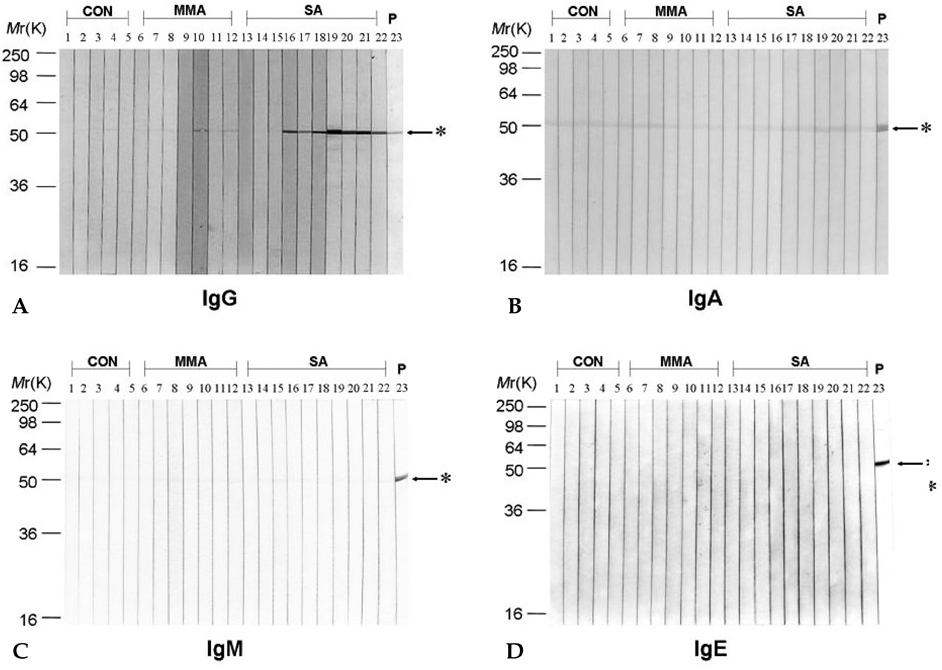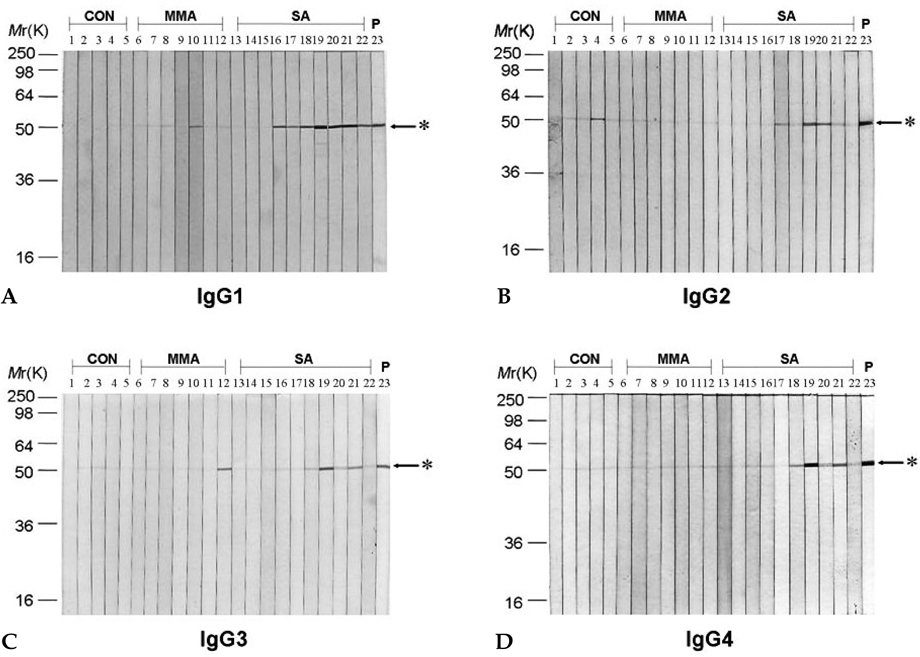Yonsei Med J.
2008 Dec;49(6):923-930. 10.3349/ymj.2008.49.6.923.
Isotype and IgG Subclass Distribution of Autoantibody Response to Alpha-enolase Protein in Adult Patients with Severe Asthma
- Affiliations
-
- 1Department of Allergy and Rheumatology, Ajou University School of Medicine, Suwon, Korea. donghonahm@yahoo.co.kr
- KMID: 1782940
- DOI: http://doi.org/10.3349/ymj.2008.49.6.923
Abstract
- PURPOSE
A possible involvement of autoimmune mechanism in the pathogenesis of bronchial asthma has been proposed. Recently, alpha-enolase protein was identified as a major autoantigen recognized by circulating IgG autoantibodies in patients with severe asthma. To evaluate a possible pathogenetic significance of these autoantibodies in severe asthma, isotype (IgG, IgA, IgM, and IgE) and IgG subclass (IgG1, IgG2, IgG3, and IgG4) distributions of autoantibodies to recombinant human alpha-enolase protein were analyzed. PATIENTS AND METHODS: We examined serum samples from 10 patients with severe asthma and 7 patients with mild-to-moderate asthma, and 5 healthy controls by immunoblot analysis. Severe asthma was defined as patients having at least 1 severe asthmatic exacerbation requiring an emergency department visit or admission in the last year despite continuous typical therapies. RESULTS: IgG1 was the predominant IgG subclass antibody response to alpha-enolase protein in patients with severe asthma. IgG1 autoantibody to alpha-enolase protein was detected in 7 of 10 patients with severe asthma (70%), 1 of 7 patients with mild-to-moderate asthma (14.3%), and none of 5 healthy controls (0%) (chi-square test; p < 0.05). IgA, IgM, and IgE autoantibodies to alpha-enolase protein could not be detected in patients with severe asthma. CONCLUSION: IgG1 subclass was the predominant type of autoantibody response to alpha-enolase protein in patients with severe asthma, suggests a possibility of IgG1 autoantibody- mediated complement activation in the pathogenesis of severe asthma.
Keyword
MeSH Terms
-
Adult
Aged
Asthma/*enzymology/*immunology
Autoantibodies/*blood/classification
Autoantigens
Case-Control Studies
Complement Activation
Female
Humans
Immunoglobulin G/blood/classification
Immunoglobulin Isotypes/blood
Male
Middle Aged
Phosphopyruvate Hydratase/*immunology
Recombinant Proteins/immunology
Young Adult
Figure
Cited by 1 articles
-
Autoimmune Responses in Severe Asthma
Manali Mukherjee, Parameswaran Nair
Allergy Asthma Immunol Res. 2018;10(5):428-447. doi: 10.4168/aair.2018.10.5.428.
Reference
-
1. Mechanisms of asthma. Global Initiative for Asthma: Global strategy for asthma management and prevention. 2002. Bethesda, Md.: National Institutes of Health;50–66. NIH publication no. 02-3659.2. The ENFUMOSA study group. The ENFUMOSA cross-sectional European multicentre study of the clinical phenotype of chronic severe asthma. Eur Respir J. 2003. 22:470–477.3. Busse WW, Banks-Schlegel S, Wenzel SE. Pathophysiology of severe asthma. J Allergy Clin Immunol. 2000. 106:1033–1042.
Article4. Rottem M, Shoenfeld Y. Asthma as a paradigm for autoimmune disease. Int Arch Allergy Immunol. 2003. 132:210–214.
Article5. Virchow JC Jr, Kroegel C, Walker C, Matthys H. Inflammatory determinants of asthma severity: mediator and cellular changes in bronchoalveolar lavage fluid of patients with severe asthma. J Allergy Clin Immunol. 1996. 98:S27–S33. discussion S33-40.6. Wagner V, Tomsikova A, Sach J, Jankova J, Novackova D. Autoimmune mechanism in diseases of the respiratory tract. Acta Allergol. 1965. 20:1–9.7. Nahm DH, Lee YE, Yim EJ, Park HS, Yim H, Kang Y, et al. Identification of cytokeratin 18 as a bronchial epithelial autoantigen associated with nonallergic asthma. Am J Respir Crit Care Med. 2002. 165:1536–1539.
Article8. Lassalle P, Delneste Y, Gosset P, Gras-Masse H, Wallaert B, Tonnel AB. T and B cell immune response to a 55-kDa endothelial cell-derived antigen in severe asthma. Eur J Immunol. 1993. 23:796–803.
Article9. Dekker JW, Nizankowska E, Schmitz-Schumann M, Pile K, Bochenek G, Dyczek A, et al. Aspirin-induced asthma and HLA-DRB1 and HLA-DPB1 genotypes. Clin Exp Allergy. 1997. 27:574–577.
Article10. Kero J, Gissler M, Hemminki E, Isolauri E. Could TH1 and TH2 diseases coexist? Evaluation of asthma incidence in children with coeliac disease, type 1 diabetes, or rheumatoid arthritis: a register study. J Allergy Clin Immunol. 2001. 108:781–783.
Article11. Holgate ST. Cytokine and anti-cytokine therapy for the treatment of asthma and allergic disease. Cytokine. 2004. 28:152–157.
Article12. Kon OM, Kay AB. Anti-T cell strategies in asthma. Inflamm Res. 1999. 48:516–523.
Article13. Nahm DH, Lee KH, Shin JY, Ye YM, Kang Y, Park HS. Identification of alpha-enolase as an autoantigen associated with severe asthma. J Allergy Clin Immunol. 2006. 118:376–381.
Article14. Lee KH, Chung HS, Kim HS, Oh SH, Ha MK, Baik JH, et al. Human alpha-enolase from endothelial cells as a target antigen of anti-endothelial cell antibody in Behçet's disease. Arthritis Rheum. 2003. 48:2025–2035.15. Nahm DH, Park HS. Analysis of induced sputum for studying allergen-specific IgE antibodies in airway secretion from asthmatic patients. Clin Exp Allergy. 1998. 28:686–693.
Article16. Paul S, Said SI, Thompson AB, Volle DJ, Agrawal DK, Foda H, et al. Characterization of autoantibodies to vasoactive intestinal peptide in asthma. J Neuroimmunol. 1989. 23:133–142.
Article17. Terrier B, Degand N, Guilpain P, Servettaz A, Guillevin L, Mouthon L. Alpha-enolase: a target of antibodies in infectious and autoimmune diseases. Autoimmun Rev. 2007. 6:176–182.
Article18. Girard JP, Dami J. Antigenic properties of lung tissue. Presence of specific antibodies in certain chronic respiratory disorders. Poumon Coeur. 1973. 29:267–270.19. Szczeklik A, Nizankowska E, Serafin A, Dyczek A, Duplaga M, Musial J. Autoimmune phenomena in bronchial asthma with special reference to aspirin intolerance. Am J Respir Crit Care Med. 1995. 152:1753–1756.20. Lee SH, Rhim T, Choi YS, Min JW, Kim SH, Cho SY, et al. Complement C3a and C4a increased in plasma of patients with aspirin-induced asthma. Am J Respir Crit Care Med. 2006. 173:370–378.
Article21. Wills-Karp M, Koehl J. New insights into the role of the complement pathway in allergy and asthma. Curr Allergy Asthma Rep. 2005. 5:362–369.
Article22. Callerame ML, Condemi JJ, Bohrod MG, Vaughan JH. Immunologic reactions of bronchial tissues in asthma. N Engl J Med. 1971. 284:459–464.
Article23. Fregonese L, Swan FJ, van Schadewijk A, Dolhnikoff M, Santos MA, Daha MR, et al. Expression of the anaphylatoxin receptors C3aR and C5aR is increased in fatal asthma. J Allergy Clin Immunol. 2005. 115:1148–1154.
Article24. Wakui H, Imai H, Komatsuda A, Miura AB. Circulating antibodies against alpha-enolase in patients with primary membranous nephropathy (MN). Clin Exp Immunol. 1999. 118:445–450.25. Holdsworth SR, Kitching AR, Tipping PG. Th1 and Th2 T helper cell subsets affect patterns of injury and outcomes in glomerulonephritis. Kidney Int. 1999. 55:1198–1216.
Article26. Jenmalm MC, Björkstén B, Macaubas C, Holt BJ, Smallacombe TB, Holt PG. Allergen-induced cytokine secretion in relation to atopic symptoms and immunoglobulin E and immunoglobulin G subclass antibody responses. Pediatr Allergy Immunol. 1999. 10:168–177.
Article
- Full Text Links
- Actions
-
Cited
- CITED
-
- Close
- Share
- Similar articles
-
- IgG Subclass Distribution of Circulating IgG Autoantibodies to Airway Epithelial Cell Proteins in Adult Asthmatic Patients
- Serum IgG and IgG subclass in bronchial asthma
- Serum IgG and IgG subclass in aspirin-sensitive asthma
- A case of intravenous immunoglobulin therapy in severe aspirin - sensitive asthma patient combined with IgG1 and IgG3 subclass deficiency
- IgG and IgG subclass in asthma



